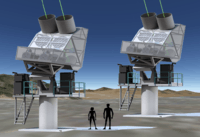Cosmology Large Angular Scale Surveyor
|
Computer-generated rendering | |
| Location(s) | Atacama Desert, Chile |
|---|---|
| Coordinates | 22°57′35″S 67°47′14″W / 22.95972°S 67.78722°WCoordinates: 22°57′35″S 67°47′14″W / 22.95972°S 67.78722°W |
| Altitude | 5,200 metres (17,100 ft) |
| Wavelength | 1.4, 2.0, 3.3, 7.5 mm (microwave) |
The Cosmology Large Angular Scale Surveyor (CLASS)[1][2][3][4][5] is an array of microwave telescopes at a high-altitude site in the Atacama Desert of Chile as part of the Parque Astronómico de Atacama.[6] The CLASS experiment aims to test the theory of cosmic inflation and distinguish between inflationary models of the very early universe by making precise measurements of the polarization of the Cosmic Microwave Background (CMB) over 70% of the sky at multiple frequencies in the microwave region of the electromagnetic spectrum.
Instrument
The CLASS instrument will survey 70% of the sky at millimeter wavelengths, in the microwave portion of the electromagnetic spectrum, from a ground-based observatory with a resolution of about 1° — approximately twice the angular size of the sun and moon as viewed from Earth. The CLASS array will consist of two altazimuth mounts that will allow the telescopes to be pointed to observe different patches of sky. The four CLASS telescopes will observe at a range of frequencies to separate emission from our galaxy from that of the CMB. One telescope will observe at 40 GHz (7.5 mm wavelength); two telescopes will observe at 90 GHz (3.3 mm wavelength); and the fourth telescope will observe in two frequency bands centered at 150 GHz (2 mm wavelength) and 220 GHz (1.4 mm wavelength). Two separate telescopes, observing at different frequencies, are housed on each mount.
The CLASS instrument is specifically designed to measure polarization. As an electromagnetic wave, light consists of oscillating electric and magnetic fields. These fields can have both an amplitude, or intensity, and a preferred direction in which they oscillate, or polarization. The polarized signal that CLASS will attempt to measure is incredibly small. It is expected to be only a few parts-per-billion change in the polarization of the already-cold CMB with a mean temperature of 2.725 K.[7] To measure such a small signal, CLASS will employ focal plane arrays with large numbers of feedhorn-coupled, transition-edge-sensor bolometers cooled to just 0.1 °C above absolute zero by cryogenic helium refrigerators. This low temperature reduces the intrinsic thermal noise of the detectors.[8][9][10]
Because water vapor in the atmosphere emits at microwave frequencies, CLASS will observe from a very dry and high-altitude site in the Andes Mountains on the edge of the Atacama Desert of Chile. Nearby sites have been chosen by other observatories for the same reason, including CBI, ASTE, Nanten, APEX, ALMA, ACT, and POLARBEAR.
Science goals
The primary science goal of CLASS is to test the theory of inflation. In physical cosmology, cosmic inflation is the leading theory of the very early universe;[11] however, observational evidence for inflation is still inconclusive. Inflationary models generically predict that a gravitational-wave background (GWB) would have been produced along with the density perturbations that seed large-scale structure. Such an inflationary GWB would leave an imprint on both the temperature and polarization of the CMB. In particular it would leave a very distinctive and unique pattern of polarization, called a B-mode pattern, in the CMB polarization. A measurement of B-mode polarization in the CMB would be important confirmation of inflation and would provide a rare glimpse into physics at ultra-high energies.[12][13]
See also
| Wikimedia Commons has media related to Cosmology Large Angular Scale Surveyor. |
References
- ↑ "CLASS: Cosmology Large Angular Scale Surveyor". The Johns Hopkins University. Retrieved 2015-08-12.
- ↑ Essinger-Hileman, T. E.; et al. (2014). Holland, Wayne S; Zmuidzinas, Jonas, eds. "CLASS: the cosmology large angular scale surveyor". Society of Photo-Optical Instrumentation Engineers (SPIE) Conference Series. Millimeter, Submillimeter, and Far-Infrared Detectors and Instrumentation for Astronomy VII. 9153: 91531I. arXiv:1408.4788
 . Bibcode:2014SPIE.9153E..1IE. doi:10.1117/12.2056701.
. Bibcode:2014SPIE.9153E..1IE. doi:10.1117/12.2056701. - ↑ "Astrophysicist, team win stimulus grant to build telescope". The Johns Hopkins University. Retrieved 2014-01-15.
- ↑ "ARRA to Help Build Telescope". Photonics Media. Retrieved 2014-01-15.
- ↑ "Johns Hopkins astrophysics team builds telescope to study origins of the universe". The Johns Hopkins University. Retrieved 2014-05-27.
- ↑ "Astronomy, Technology, Industry: Roadmap for the Fostering of Technology Development and Innovation in the Field of Astronomy in Chile" (PDF). Conicyt Ministry of Education, Government of Chile. Retrieved 2014-02-10.
- ↑ Fixsen, D. J. (December 2009). "The Temperature of the Cosmic Microwave Background". The Astrophysical Journal. 707 (2): 916–920. arXiv:0911.1955
 . Bibcode:2009ApJ...707..916F. doi:10.1088/0004-637X/707/2/916.
. Bibcode:2009ApJ...707..916F. doi:10.1088/0004-637X/707/2/916. - ↑ Eimer, J. R.; Bennett, C. L.; Chuss, D. T.; Marriage, T.; Wollack, E. W.; Zeng, L. (2012). Holland, Wayne S, ed. "The cosmology large angular scale surveyor (CLASS): 40 GHz optical design". Society of Photo-Optical Instrumentation Engineers (SPIE) Conference Series. Millimeter, Submillimeter, and Far-Infrared Detectors and Instrumentation for Astronomy VI. 8452: 845220. arXiv:1211.0041
 . Bibcode:2012SPIE.8452E..20E. doi:10.1117/12.925464.
. Bibcode:2012SPIE.8452E..20E. doi:10.1117/12.925464. - ↑ Eimer, J. R. (2013). The Cosmology Large Angular Scale Surveyor (CLASS): In Search of the Energy Scale of Inflation (Ph.D.). Johns Hopkins University.
- ↑ Appel J. W.; et al. (2014). Holland, Wayne S; Zmuidzinas, Jonas, eds. "The cosmology large angular scale surveyor (CLASS): 38-GHz detector array of bolometric polarimeters". Society of Photo-Optical Instrumentation Engineers (SPIE) Conference Series. Millimeter, Submillimeter, and Far-Infrared Detectors and Instrumentation for Astronomy VII. 9153: 91531J. arXiv:1408.4789
 . Bibcode:2014SPIE.9153E..1JA. doi:10.1117/12.2056530.
. Bibcode:2014SPIE.9153E..1JA. doi:10.1117/12.2056530. - ↑ Linde, A. (2014). "Inflationary Cosmology after Planck 2013". arXiv:1402.0526
 [hep-th].
[hep-th]. - ↑ Boyle, Latham A.; Steinhardt, PJ; Turok, N (2006). "Inflationary predictions for scalar and tensor fluctuations reconsidered". Physical Review Letters. 96 (11): 111301. arXiv:astro-ph/0507455
 . Bibcode:2006PhRvL..96k1301B. doi:10.1103/PhysRevLett.96.111301. PMID 16605810.
. Bibcode:2006PhRvL..96k1301B. doi:10.1103/PhysRevLett.96.111301. PMID 16605810. - ↑ Tegmark, Max (2005). "What does inflation really predict?". JCAP. 0504 (4): 001. arXiv:astro-ph/0410281
 . Bibcode:2005JCAP...04..001T. doi:10.1088/1475-7516/2005/04/001.
. Bibcode:2005JCAP...04..001T. doi:10.1088/1475-7516/2005/04/001.
External links
| Wikimedia Commons has media related to WMAP. |

